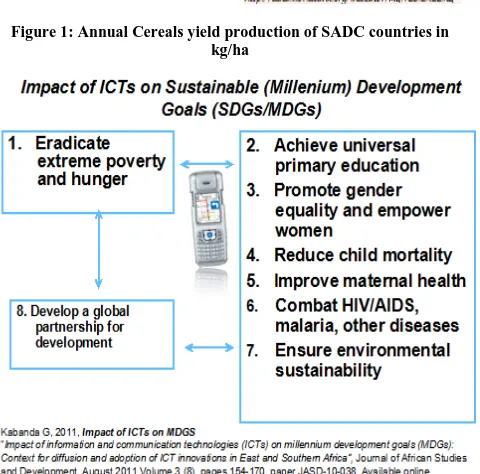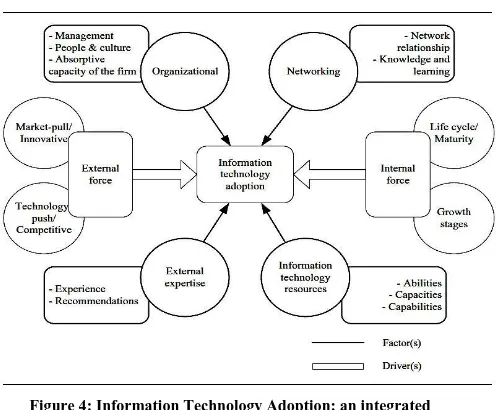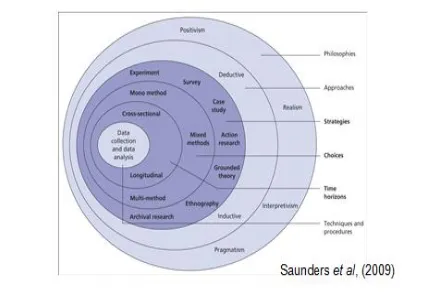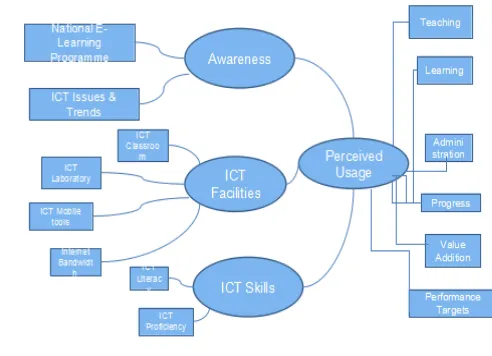International Journal of Emerging Technology and Advanced Engineering
Website: www.ijetae.com (ISSN 2250-2459, ISO 9001:2008 Certified Journal, Volume 6, Issue 12, December 2016)
23
Pathways to Developing Transformative ICT Skills for
Sustainable Development in Zimbabwe
Prof. Gabriel Kabanda
1 1Zimbabwe Open University
Abstract— The emergence and convergence of information and communication technologies (ICTs) has remained as the catalyst for global socio-economic transformations and the attainment of sustainable development goals. The purpose of the research was to determine pathways for transformative ICT skills for sustainable development. Constructionism and constructivism education paradigms are used as a basis for the ICT skills development. Innovation in e-learning and mobile learning can be identified by technology affordances where the Frame model is recommended for the Zimbabwean situation. Structuration theory asserts that people create the structures in which they live, as much as structures constrain and provide them with opportunities for action. The main research methodology used is qualitative and the research design used was a focus group discussion with a homegenous group of 6 seasoned academics and researchers. A structural equation model for the ICT skills development was developed as a way of testing the complex relationships between observed (measured) and unobserved (latent) variables and also between two or more latent variables. Human capital development strategies are recommended for Zimbabwe.
Keywords—ICTs, ICT4D, structuration theory, technology affordances, structural equation modelling, sustainable development.
I. INTRODUCTION
The emergence and convergence of information and communication technologies (ICTs) has remained as the catalyst for global socio-economic transformations and the attainment of sustainable development goals. The impact of ICT adoption on the business sector is known to include performance, growth, expansion, and support of new products (Consoli, 2012, as cited in Tarutė & Gatautis, 2014:1221). The ICT technological change requires extensive investments into people (labour) and capital for the infrastructure and equipment. High productivity levels arising from skilled manpower in ICTs results in huge phenomenal growth and multiplicity of production levels, as defined by the Cobb-Douglas production function (Kabanda G., 2008).
The Cobb-Douglas production function relates the productivity levels from ICT to labour and capital. A Cobb-Douglas production function of the form
Q = A Ka Lb
is used for the analysis of technological progress and attended economic growth, where A, a and b are empirical parameters.
a. K = capital input (very meaningful mounts) b. L = labour input (high technical competence)
International Journal of Emerging Technology and Advanced Engineering
Website: www.ijetae.com (ISSN 2250-2459, ISO 9001:2008 Certified Journal, Volume 6, Issue 12, December 2016)
[image:2.612.50.300.116.605.2]24
Figure 1: Annual Cereals yield production of SADC countries inkg/ha
Figure 2: Impact of ICTs on Sustainable Development Goals
The basic driving force behind economic growth is technological change, where an endogenous growth model is adopted for Zimbabwe. The core problems of sustainable development in Zimbabwe associated with ICTs are as follows:
1.Inadequate human capital development
2.Cyber security, cyber bullying and child protection on the Internet
3. Balancing privacy and surveillance (wikileaks, data leakage, etc.)
4. Electronic waste and carbon emissions
5. Ergonomics, which is about possible public concern about health effects
6. Digital exclusion, especially for the previously marginalised groups in society.
Constructionism and constructivism education paradigms are used as a basis for the ICT skills development. The education paradigms for the development of ICT skills and competences include the following:
c. Constructivism – where learners generate and learn from their own experiences
d.Constructionism - where individual learners construct mental models to understand the world around them e. Collaborative Learning
f. Creativity Stimulation
g.Protagonist – the main character in a drama or story h.Formal and informal spaces
ICT skills development requires an understanding of technology affordances and the relevant education paradigms. An affordance is often taken as a relation between an object, or an environment, and an organism that affords the opportunity for that organism to perform an action (Kabanda G., 2014). Affordances are the interactions between users and tool, i.e., the perceived and actual properties of an object that determine how it could possibly be used. The tool prompts, guides, or constrains the users depending on their previous experiences (Salomon, 1990).
Statement of the Problem
Zimbabwe faces a sustainable economic development problem. Zimbabwe needs to adequately prepare for a strategic response to ICTs and explore and develop new transformative pathways for ICT skills and sustainable development in an increasingly networked world. The development of ICT skills through teaching and learning of and about ICTs is motivated by the changing face of delivery of human capital development, the role of the teacher and the changing environment requiring ongoing training, support and development.
Purpose or Aim
The purpose of the research was to determine pathways for transformative ICT skills for sustainable development. These are essentially ICT Pathways for:
[image:2.612.53.293.356.593.2]International Journal of Emerging Technology and Advanced Engineering
Website: www.ijetae.com (ISSN 2250-2459, ISO 9001:2008 Certified Journal, Volume 6, Issue 12, December 2016)
25
j. Poverty reduction
k. Social problems value chain
Research Questions
The critical research questions are as follows:
l. How can poor people benefit economically from using ICTs?
m.Which ICTs can be used by low-income entrepreneurs? n. How do we develop skills and competences in
Zimbabwe to make significant national progress and industrialization in a country blessed with both an abundance of natural resources and a high literacy rate of 92%?
o. How do you integrate sustainability literacy and competence into ICT4D through the transformative ICT skills and leadership skills necessary for the knowledge economy?
p. How do you extend social inclusion and social mobility through ICT pathways for poverty reduction?
II. LITERATURE REVIEW
ICT4D is premised on the understanding that ICTs can contribute to the improvement of socio-economic conditions in developing countries (Mann, 2004; Sahay, 2001; Walsham et al., 2007), as guided by the United Nations‘ Sustainable Development Goals (SDGs). Within the context of ICT4D, ICT innovation is a source of influence on technological change and attainment of sustainable development. Avgerou (2008)'s Three Discourses (diffusion, more elaborate ontologies of information systems (IS) innovation which are socially constructed entities, and the transformative IS innovation intervention) provide a strategic direction to be taken with regards to ICT4D in Zimbabwe. ICT innovation in Zimbabwe, dominated by the increased popularity of the use of Econet Wireless‘s Ecocash for mobile money transfer and the use of Whatsapp, has made value-adding contributions to the socio-economic transformation of society, now regarded as a the main driver for the transfer and diffusion of technology and as a socially embedded innovation and progressive step (Avgerou, 2010). It has become a widespread phenomena that village boys are now seen herding cattle in the rural areas fully equipped with mobile phones and grandmothers working in the fields are increasingly networked and equipped to actively participate financial and business transactions as digital natives.
ICT innovation with its cognitive and the social embeddedness discourse brings meaning to the developmental capacity of ICT (Avgerou, 2010). The key driver to this innovation is ICT skills development.
Figure 3 shows the link between technology, organisation and the environment (TOE). The TOE framework was developed in 1990 (Tornatzky and Fleischer, 1990). According to the TOE framework, the process for the adoption and implementation of an information technology innovation in an enterprise spans over the technological, organizational and environmental contexts. The TOE framework is consistent with the diffusion of innovation (DOI) theory, in which Rogers (1995) presented the internal and external characteristics of the organization as the drivers for organizational innovateness, which are similar to the technology and organization context of the TOE framework. The TOE can be a useful analytical framework for assessing various types of IT innovations. In summary, information technology adoption in business organisations of different sizes are shown on Figure 4.
Innovation in e-learning and mobile learning can be identified by the concept of technology affordances. In this respect, technology affordances show innovative results in the following areas (Traxler J.,2009):
q.Technology-driven mobile learning where specific technological innovation is deployed in an academic setting to demonstrate technical feasibility and pedagogic possibility;
r. Miniature but portable e-learning that uses mobile, wireless, and hand-held technologies that re-enact approaches and solutions already used in conventional e-learning;
s. Connected classroom learning that support collaborative learning and may include interactive whiteboards; t. Informal, personalized, situated mobile learning
enhanced with additional functionality to deliver educational experiences;
u.Mobile training/ performance support to improve the productivity and efficiency of mobile workers; and v.Remote/rural/development mobile learning that
International Journal of Emerging Technology and Advanced Engineering
Website: www.ijetae.com (ISSN 2250-2459, ISO 9001:2008 Certified Journal, Volume 6, Issue 12, December 2016)
[image:4.612.54.295.138.334.2]26
Figure 3: Technology, Organisation and Environment framework (Tornatzky & Fleischer 1990, adapted from Oliveira et al., 2011:112)Figure 4: Information Technology Adoption: an integrated framework (Nguyen, 2009:164)
ICT affordances can maximise innovation opportunities in the following three key elements (Wijekumar K.J. et al, 2006):
w.Accessibility - this is where the Internet ‗affords‘ opportunities for accessing information and knowledge in a new way. This affordance faces a primary challenge from finding to selecting relevant information.
x.Speed of change - this refers to attempts to understand the question of how technology can‗be used to enable students to navigate their way through the myriad of changing information and make more informed decisions'.
y.Other affordances relevant to the learner include diversity, communication and collaboration, reflection, multi-modal and non-linear learning, etc. It is argued that ‗Perhaps new forms of reflection and critique will emerge in response to more transitory and digital text.‘ The recommended model for e-learning and mobile learning is the Frame Model (Koole, 2009), which is illustrated in Figure 5 below. The advantages of mobile learning (Koole M.L., 2009) are:
z. Wireless, networked mobile devices can enable learners to access relevant information when and where it is needed at various locations.
aa. The ability to access a variety of materials from anywhere at anytime can provide multiple cues for comprehension and retention.
bb. Learning within specific contexts can provide authentic cultural and environmental cues for understanding the uses of information which may enhance encoding and recall.
cc. Well-implemented mobile education can assist in the reduction of cognitive load for learners. While it is difficult to determine how to chunk information, differing patterns of presentation and amounts of information can potentially help learners to retain, retrieve, and transfer information when needed.
[image:4.612.53.301.364.569.2]International Journal of Emerging Technology and Advanced Engineering
Website: www.ijetae.com (ISSN 2250-2459, ISO 9001:2008 Certified Journal, Volume 6, Issue 12, December 2016)
27
Structuration theory is a social ontology, defining what sorts of things exist in the world, rather than setting out laws of development or suggesting clear hypotheses about what actually happens. It tells us what we are looking at when we study society rather than how a particular society actually works. Structuration theory asserts that people create the structures in which they live, as much as structures constrain and provide them with opportunities for action. This structuration theory is about structure in relation to human action, i.e. structures shape people‘s actions and practices but those in turn make up and replicate the structures themselves. This means that structures are mutable and that human actions can reshape the very structures that gave them the ability to act in the first place. The basic driving force behind economic growth is technological change. Technological change is endogenous, being determined by deliberate activities of economic agents acting largely in response to financial incentives. Inclusive pedagogies in teacher education, which are based on the structuration theory, demonstrated transformative pathways using the the ontological, epistemological and technical aspects (Gudjonsdottir H. et al., 2007).III. RESEARCH METHODOLOGY
[image:5.612.63.280.513.665.2]The approach to the research philosophy, research design and data collection is illustrated by the research onion shown on Figure 6 below (Saunders et al, 2009).
Figure 6: Research methodology research onion
The main research methodology used is qualitative. The research design used was a focus group discussion held with 6 Professors from Zimbabwe Open University during the corporate planning sessions. This was a homegenous group of seasoned academics and researchers.
Focus groups can reveal a wealth of detailed information and deep insight. The focus group created an accepting environment that put the participants at ease allowing then to thoughtfully answer questions in their own words and add meaning to their answers. The researcher moderated the focus group for one hour with a view to generate a maximum number of different ideas and opinions from as many different people in the time allotted. Both engagement and exploration questions were asked in accordance with the research questions.
IV. RESULTS AND ANALYSIS
The focus group posited that the critical elements for ICT4D in Zimbabwe are:
dd. access to ICTs; ee. ability to use ICTs; ff. actual use of ICTs; and
gg. the impact of using ICTs in economic growth. The ICT development index is a valuable tool for benchmarking the most important indicators for measuring the information society. This is a standard tool that governments, operators, development agencies, researchers and others can use to measure the digital divide and compare ICT performance within and across countries. The most commonly used ICT development indices related to access to ICTs include the following:
hh. Fixed-telephone subscriptions/100 inhabitants
ii. Mobile cellular telephone subscriptions / 100 inhabitants
jj. International internet bandwidth (bits/s) per user kk. Percentage of households with a computer ll. Percentage of households with internet access
International Journal of Emerging Technology and Advanced Engineering
Website: www.ijetae.com (ISSN 2250-2459, ISO 9001:2008 Certified Journal, Volume 6, Issue 12, December 2016)
28
Table 1:Key ICT development indices for Zimbabwe for 2016 (Source: POTRAZ Second Quarter 2016 Report)
The changing landscape and business requirements requires ICT Skills required to cope in Zimbabwe, which requires a balance on breadth and depth of the ICT skills. IT and business are becoming inextricably interwoven. Technology has become a catalyst of social change and innovation. An innovation can be defined as the adoption of a new idea that enables an organisation to gain and sustain a competitive advantage. There is technological innovation (incremental and radical) and administrative innovation. ICT skills are critical elements for innovation as we focus on the rise of a knowledge economy.
The focus group discussion listed the following technological futures for ICT in Zimbabwe where skills are required for the future:
mm.Biometrics nn. Cloud Computing oo. Complexity
pp. Intelligent Sensor Networks and Ubiquitous Computing
qq. New Computing Technologies rr. Next Generation Networks ss. Photonics
tt. Service and Swarm Robotics uu. Searching and Decision-Making vv. Secure Communication
ww. Simulation and Modelling xx. Supercomputing
yy. Surveillance
According to the focus group discussion, the education paradigm should reflect collaborative learning, creativity stimulation, protagonist approaches, and formal and informal spaces. Critical skills required for the future including migration skills, application skills, cloud security skills, batabase skills, programming skills, Linux skills, business operations management, stakeholder management, and collaboration skills. These need to be broadened and calibrated at the national level, where design thinking is the preferred paradigm. The focus group discussions interrogated the ICT skills requirements for Zimbabwe with respect to the following parameters, on how to:
zz. balance breadth and depth of skills?
aaa. demonstrate seamless integration between IT and business?
bbb. remove age barrier and compartimentalisation of organisations?
ccc. declining learning capacity by age?
[image:6.612.326.572.469.647.2]The ICT skills are related to the ICT facilities and awareness of the technical computing fields. Structural Equation Modelling (SEM) is used to test complex relationships between observed (measured) and unobserved (latent) variables and also between two or more latent variables. The structural equation model for the ICT skills was developed and is as shown on Figure 7 below.
Figure 7: Structural equation model for ubiquitous learning in Zimbabwe
The human capital development strategies recommended for Zimbabwe include the following:
First Qtr 2016 Second Qtr 2016
Fixed teledensity 2.60% 2.50% Mobile penetration rate 96.50% 97%
Internet penetration rate 49.80% 50.10%
Number of LTE
eNodeBs base stations 326 513
Voice traffic (minutes) 1,257,842,811.0 0
1,192,571,970.0 0
Telecommunication
revenues $237,771,722.00 $228,748,120.00
International Journal of Emerging Technology and Advanced Engineering
Website: www.ijetae.com (ISSN 2250-2459, ISO 9001:2008 Certified Journal, Volume 6, Issue 12, December 2016)
29
ddd. Increase the numbers and improve the retention of teachers/lecturers/administrators / technologists in schools and tertiary institutions
eee. Establish emphasis on exploration of innovative ways of retaining skilled manpower
fff. Empower indigenous people and reduce dependency on expatriates
ggg. Embark on private-public partnerships
hhh. Expand facilities for open and distance learning throughout the country
iii. Promote local manufacture and assembly of science and technology equipment, annual expositions and intellectual fairs
jjj. Periodically review curricula to keep abreast of the developments that are responsive to national challenges
V. CONCLUSION
The emergence and convergence of information and communication technologies (ICTs) has remained as the catalyst for global socio-economic transformations and the attainment of sustainable development goals. Information and communication technologies for development (ICT4D) refers to the application of information and communication technologies (ICTs) toward social, economic, and political development, with a particular emphasis on helping poor and marginalized people and communities. Zimbabwe faces a sustainable development evidenced by low food security and poverty reduction and these are also associated with ICTs. The education paradigms for the development of ICT skills and competences include constructivism, constructionism, collaborative learning, creativity stimulation, protagonist approaches, and formal and informal spaces of learning. Zimbabwe needs to adequately prepare for a strategic response to ICTs and explore and develop new transformative pathways for ICT skills and sustainable development in an increasingly networked world. The development of ICT skills through teaching and learning of and about ICTs is motivated by the changing face of delivery of human capital development, the role of the teacher and the changing environment requiring ongoing training, support and development. The purpose of the research was to determine pathways for transformative ICT skills for sustainable development.
Sustainability literacy can be integrated with competence into ICT4D through the transformative ICT skills and leadership skills necessary for the knowledge economy.
ICT4D is premised on the understanding that ICTs can contribute to the improvement of socio-economic conditions in developing countries, as guided by the United Nations' Sustainable Development Goals (SDGs). Within the context of ICT4D, ICT innovation is a source of influence on technological change and attainment of sustainable development. ICT innovation in Zimbabwe, dominated by the increased popularity of the use of Econet Wireless's Ecocash for mobile money transfer and the use of Whatsapp, has made value-adding contributions to the socio-economic transformation of society, now regarded as a the main driver for the transfer and diffusion of technology and as a socially embedded innovation and progressive step (Avgerou, 2010). The key driver to this innovation is ICT skills development.
The main research methodology used is qualitative and the research design used was a focus group discussion with a homegenous group of 6 seasoned academics and researchers. The most commonly used ICT development indices related to access to ICTs include the fixed telephone density, mobile density, internet penetration rate and percentage of households with access to a computer. It shows that Zimbabwe has extensively invested in infrastructural development of ICTs in the past five years. However, there is now need to shift the focus on the effective utilisation of these ICTs. The changing landscape and business requirements requires ICT Skills required to cope in Zimbabwe, which requires a balance on breadth and depth of the ICT skills.
The focus group discussion identified the following technological futures for ICT in Zimbabwe where skills are required for the future. Critical skills required for the future including migration skills, application skills, cloud security skills, batabase skills, programming skills, Linux skills, business operations management, stakeholder management, and collaboration skills. The structural equation model for the ICT skills development was developed. Human capital development strategies are recommended for Zimbabwe to ensure adequate ICT skills development and competences.
REFERENCES
[1] Avgerou C., 2008, ―Information Systems in developing countries: a critical research review‖, Journal of Information Technology, vol 23, no 3, pp133-146 (2008).
[2] Avgerou C., 2010, ―Discourses on ICT and Development‖, Information Technologies & International Development, Volume 6, Number 3, Fall 2010 .
International Journal of Emerging Technology and Advanced Engineering
Website: www.ijetae.com (ISSN 2250-2459, ISO 9001:2008 Certified Journal, Volume 6, Issue 12, December 2016)
30
[4] Gudjonsdottir H., Cacciatolo M., Davies A., Kelyy C., and Dalmu M. C., 2007, ―Transformative Pathways: Inclusive Pedagogies in Teacher Education‖, Journal of Research on Technology in Education, Volume 40 Issue 2, pages 165-182, International Society for Technology in Education, 000.336.5191, USA.
[5] Kabanda G., 2008, ― Collaborative opportunities for ICTs development in a challenged African environment‖, published in the Journal of Technology Management & Innovation, August 2008, Volume 3 Number 3 of 2008, pages 91-99, ISSN 0718-2724. [6] Kabanda G., 2011, ―Impact of information and communication
technologies (ICTs) on millennium development goals (MDGs): Context for diffusion and adoption of ICT innovations in East and Southern Africa‖, Journal of African Studies and Development, August 2011 Volume 3 (8), pages 154-170, paper JASD-10-038, Available online.
[7] Kabanda G., 2014, ―Technology affordances and diffusion of Mobile
Connectivity and Applications in Zimbabwe‖, June 2014, The International Journal of Emerging Technology and Advanced Engineering, Volume 4, Issue 6, June, 2014, pages 13-23, ISSN
2250–2459 (Online).
http://www.ijetae.com/files/Volume4Issue6/IJETAE_0614_116.pdf. [8] Koole M.L., 2009, ―A model for Framing Mobile Learning‖, p26-30,
a book chapter in Mobile LearningTransforming the Delivery of Education: and Training, edited by Mohamed Ally, published by AU Press, Athabasca University, ISSN 1919-4382 Issues in Distance Education Series (Print), ISSN 1919-4390 Issues in Distance Education Series (Online).
[9] Mann, C. L., 2004, Information technologies and international development: Conceptual clarity in the search for commonality and diversity. Information Technologies & International Development 1(2), 67–79.
[10] Nguyen, T.U.H., 2009, Information technology adoption in SMEs: An integrated framework. Int. J. Entrep. Behav. Res. 2009, 15, 162– 186, doi:10.1108/13552550910944566.
[11] Rogers, E.M. (1995) Diffusion of innovations, Fourth Edition ed., New York, Free Press.
[12] S a l o m o n , G . ( 1 9 9 0 ) . T h e c o m p u t e r l a b : A b a d i d e a n o w s a n c ti fi ed . Educational Technology, 30, 5 0 – 5 2 . [13] Sahay, S. , 2001, Introduction to the special issue on ―IT and Health
Care in Developing Countries.‖ Electronic Journal on Information Systems in Developing Countries 5(0), 1–6.
[14] Saunders M., Lewis P. And Thornhill A., 2009, Research Methods for Business Students, Fifth Edition.Prentice Hall, Pearson Education.ISBN: 978-0-273-71686-0. www.pearsoned.co.uk. [15] Traxler J., 2009, ―Current State of Mobile Learning‖, p12-13, a
book chapter in Mobile LearningTransforming the Delivery of Education: and Training, edited by Mohamed Ally, published by AU Press, Athabasca University, ISSN 1919-4382 Issues in Distance Education Series (Print), ISSN 1919-4390 Issues in Distance Education Series (Online).
[16] Tornatzky, L.G., and Fleischer, M. The Processes of Technological Innovation. Lexington Books, Lexington, Massachusetts, 1990. [17] Walsham, G., Robey, D., & Sahay, S., 2007, Special issue on
information systems in developing countries. MIS Quarterly 31(2), 317–326.



